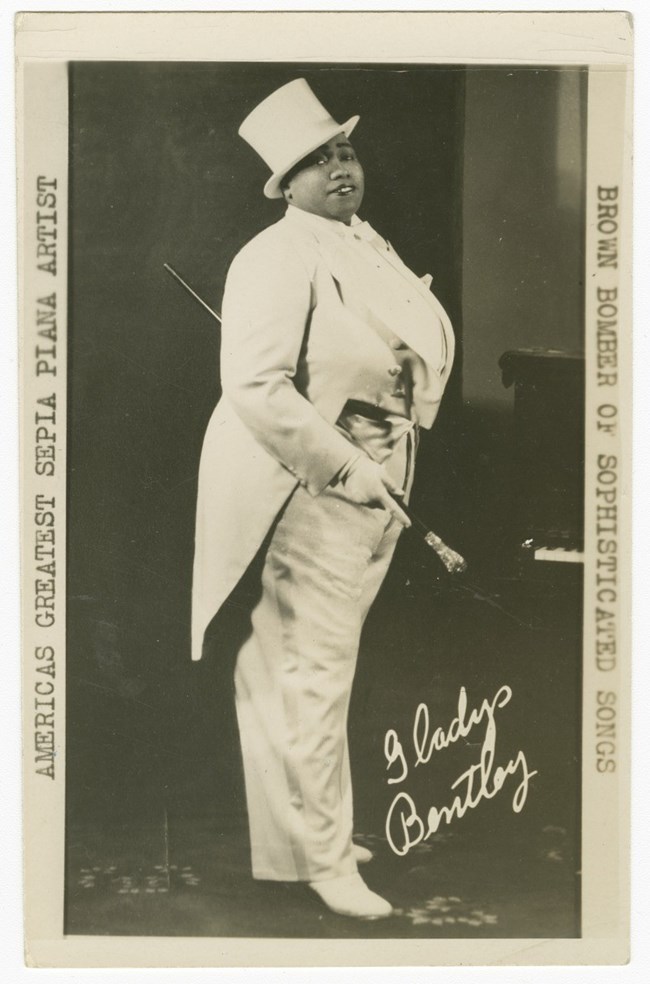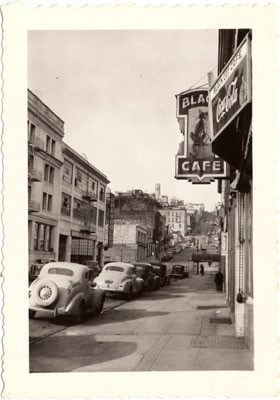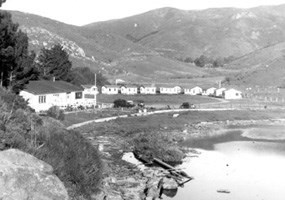Last updated: March 6, 2025
Article
Armed Forces Disciplinary Control Board
With its location on the Pacific, the Bay Area has seen thousands of service members come through its shores. This military presence both sabotaged and fostered the LGB community the area is known for today. During the World Wars, homosexual soldiers were subject to court martial, dishonorable discharge or hospitalization. As soldiers returned to the Presidio of San Francisco, and other military bases, ‘in the closet’ they had to stay that way even off base. The Armed Forces Disciplinary Control Board served as an agent of harassment for LGB servicemen and the establishments they patronized.

Smithsonian National Museum of African American History and Culture.
LGB Night Life
Prior to World War II, LGB clubs thrived in San Francisco and the Bay Area. Many featured gender stage performance and impersonation, known today as “drag”. Located in the North Beach neighborhood, the Beige Room and Finocchio’s nightclub were well known for drag entertainment. At the Beige Room especially, performers were allowed more freedom of expression and redefined drag culture. Mona's 440 Club featured tuxedo wearing male impersonating performers. Their most famous guest performer, Gladys Bentley, dressed in men’s clothing and sang openly about relationships with women. Mona’s, and nearby, Tommy’s Place served lesbian clientele and performers. All these places created a bustling nightlife in the North Beach neighborhood that drew crowds of LGB people, tourists, and servicemen alike.
Homosexuality and cross dressing were illegal at the time. Local police in San Francisco and the surrounding areas often harassed establishments that catered to the LGB community. The State Board of Equalization (SBE) would often take a bar’s liquor license for serving members of the queer community. In 1941 Congress passed the May Act. Which authorized the military to survey and admonish LGB recreational hangouts near military bases. The Army Police and the Navy joined forces in 1944 to create the Armed Forces Disciplinary Control Board (AFDCB).
The Black Cat Cafe vs. California Supreme Court
Following the May Act, The AFDCB board created a list of establishments that were off limits for service members. If found there, soldiers were subject to arrest, court martial, and dishonorable discharge. AFDCB would require these establishments to put “Off Limits” signs in their windows. Mona’s 440 Club, Finocchio's Nightclub, The Beige Room, and The Black Cat were all indicated. This made them popular destinations amongst service members and tourists alike out of curiosity. Many establishments experienced a cyclical pattern: harassment from police; reports to AFDCB; warnings, then required signage, and liquor license revocation. This pattern was temporarily disrupted in 1949 with the Black Cat Cafe. A bar made famous by renowned performer and activist Jose Sarria.

San Francisco Public Library
SBE indefinitely suspended The Black Cat’s liquor license because it was “a hangout for homosexuals.”1 The owner fought this decision and the case went to the California Supreme Court in 1950. The court overruled SBE’s suspension and required that the Black Cat be given its license back the following year.2 This was a turning point: an establishment could not be discriminated against solely because LGB people were there. Between, 1951-1955 more LGB spaces were bought by members of the community, securing their ownership.
The Black Cat case may have deterred local and state antics, but it did not stall harassment from AFDCB. In 1951, AFDCB petitioned SBE at the federal level to mandate signage at LGB clubs. The Board held monthly hearings to identify these spaces and mark them. Pearl’s, an LGB bar in Oakland, was required to attend a hearing. The owner said “[I] could see no reason for eliminating homosexuals from patronage as long as they did not annoy the other customers... [I] would rather not have service personnel.”3 By 1954, AFDCB cited dozens of establishments as off limits, semi permanently.
As mandated by the California Supreme Court decision: law officers could not arrest LGB people “unless a crime was committed”. The Armed Forces could not rely on their mere presence as just cause anymore. In response, police departments started looking for other charges to make. The Marin County District Attorney told the San Rafael Daily Independent Journal that “we are going to start picking them up on charges of vagrancy and putting them in the jail."4
Marin County Makes Headlines
In October 1954 the Sausalito NEWS wrote, “Three Sausalito Bars are among the Bay Area taverns undergoing a military survey to determine whether they are ‘sex deviate hang-outs’. The survey was announced this week by the Armed Forces Disciplinary Control Board. The board had indicated that if the bars in question are found to be homosexual bars, they will be placed off-limits to servicemen. Sausalito Police Chief Alden Ingalls told the NEWS yesterday that there are two such taverns in Sausalito, and although the police are keeping a watchful eye on these places, as yet they have no case against any sex deviate. Another Marin bar under military surveillance is located in Stinson Beach.”5 Stinson Beach, in Marin County, was viewed as a “vulnerable” area given it's suburban lifestyle. The police department wanted plain clothes officers there to “help arrest the sex deviates.”6
Things changed for the worse for LGB establishments in 1955. California created a new agency called the Alcoholic Beverage Control Board (ABCB) and they “declared war on homosexual bars in San Francisco”. The Black Cat court ruling made it legal for LGB people to assemble, but only if they were “orderly”. Police departments began to redefine what constituted “orderly homosexual behavior”. People started getting arrested for touching the leg of a same gender person, or women wearing masculine clothing and vice versa. Officers would often go undercover to collect evidence: their testimonies often used in court proceedings. The AFDCB now had support from the state legislators and judges.

George Kristian Lindholt
Unintended Outcomes
Transgender women were the most susceptible to violence and police harassment. Many frequented 24 hour diner, Gene Compton’s Cafeteria in San Francisco, to the dismay of its owner. Tamara Ching, a transgender woman who frequented the diner said, "The police could harass you at any time, they would ask you for pieces of ID. You had to have your male ID if you were born male…"8 After countless instances of discrimination tensions erupted in August 1966. This event is now known as the Compton Cafeteria Riots. An early example of resistance by trans, lesbian, and queer people.
As raids and arrests continued, many LGB people fought to protect the few places they felt safe. Local bars and clubs admonished by the AFDCB, became unintentional epicenters for this fight.
“Ironically, the increasing harassment of gay men and lesbians in the armed services.. helped to build a sense of community among its victims. By uprooting an entire generation, the war helped channel urban gay life into a particular path of growth—away from stable private networks and toward public commercial establishments” --- Allan Bérubé , Coming Out Under Fire9
Sources:
1-3 Nan Alamilla Boyd. Wide-Open Town : A History of Queer San Francisco to 1965. Berkeley, Calif. ; London, University Of California Press, 2003.
4, 6 “’Keep Out of Marin’ Sex Deviates Told.” Daily Independent Journal [San Rafael, CA] 4 Oct. 1954, p. 1.
5 “Three Sausalito Bars Are Under Military Survey” Sausalito News, Volume LXIX, Number 43, 29 October 1954 p. 1.
7 “4 Mill Valley Men Netted in 'Biggest Raid’” Mill Valley Record, Volume 58, 4 July 1957 p. 1.
8 Pasulka, Nicole. “Ladies in the Streets: Before Stonewall, Transgender Uprising Changed Lives.” NPR.org, 5 May 2015.
9 Bérube,́ Allan. Coming out under Fire : The History of Gay Men and Women in World War II. 1990. Chapel Hill, University Of North Carolina Press, 2010.
